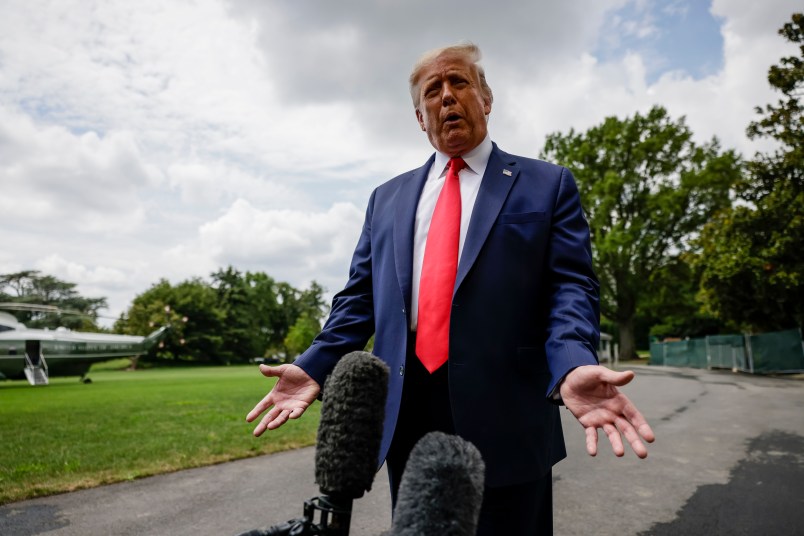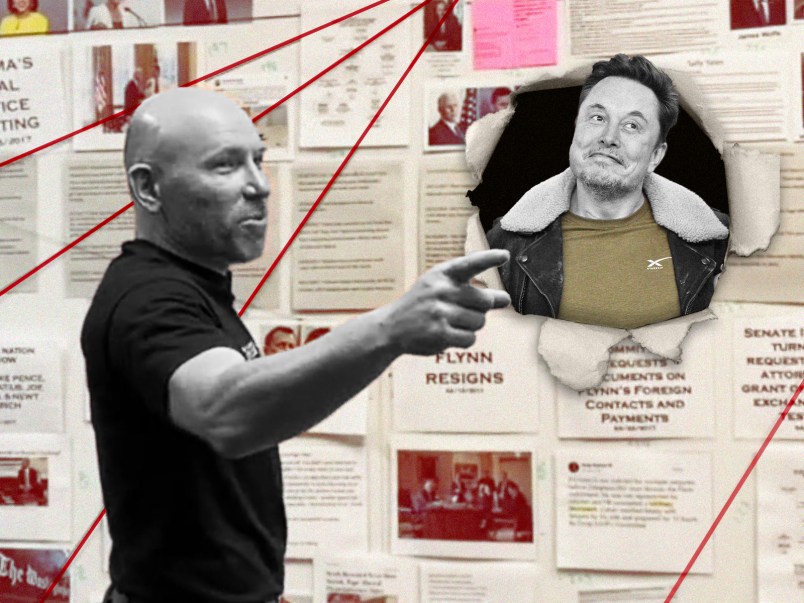President Donald Trump signed a series of executive actions Saturday afternoon, a move he telegraphed from a Friday press conference from his golf club in Bedminster, New Jersey.
The actions, Trump said Saturday, centered on reinstating unemployment insurance benefits (though at a lower level), deferring the federal payroll tax, extending the eviction moratorium and deferring student loan payments and forgiving interest.
Many of the actions are likely to prompt lawsuits.
“If we get sued, it’s somebody who doesn’t want people to get money,” Trump said.
As he wandered into various campaign issues for the first minutes of his speech, he promised that the coming actions would “take care of pretty much this entire situation.”
Trump said that he’d extend unemployment insurance benefits at a level of $400 per week, 75 percent of which will be covered by the federal government and 25 percent of which will be covered by the states. Before its expiration, the benefit ran at $600 a week.
The executive action would take money from states’ funds allocated by the CARES Act and the Department of Homeland Security’s Disaster Relief Fund. The White House has previously indicated its belief that it can use a not-yet-spent $81 billion from the CARES Act, as well as direct the Labor Department to loan states money to help bolster the benefit. The CARES Act doesn’t explicitly ban Trump from using the aid for unemployment benefits, but will prompt anger — if not a lawsuit — from Congress over executive overreach into its power of the purse.
The action raises a host of new questions for unemployed Americans, including how long the new program would take to get underway.
On the payroll tax deferment, Trump said that it would last the rest of 2020 for people making less than $100,000 a year, and that the tax would be permanently eliminated if he wins in November. He had previously expressed his interest in deferring the payroll tax payments, though the idea was unpopular with members of both parties who worried that the lack of payment would seriously harm the funding of Medicare and Social Security.
On the rent eviction moratorium, he said that he will direct the Department of Housing and Urban Development to, along with the moratorium, provide financial assistance to renters and landlords, though he did not provide specifics. The action does not actually prevent evictions and provides little more than suggestions to HUD on how to help renters avoid evictions under current law: “Such action may include encouraging and providing assistance to public housing authorities, affordable housing owners, landlords, and recipients of Federal grant funds in minimizing evictions and foreclosures,” the executive memorandum reads.
With the student loan deferment action, Trump said that the administration would be “extending this policy through the end of the year and further than that most likely.”
He also said that he was “looking at” income and capital gains tax cuts, the former mainly for “middle income and lower income people.”
Trump had pledged to act Friday “if Democrats continue to hold this critical relief hostage” after his negotiators, Treasury Secretary Steve Mnuchin and White House Chief of Staff Mark Meadows, failed to broker a compromise with House Leader Nancy Pelosi (D-CA) and Senate Minority Leader Chuck Schumer (D-NY). He specifically cited all of the actions he ultimately signed Saturday.
He made that announcement from Bedminster as well, to a crowd of initially maskless collared-shirt wearing country club members. The event turned into a pseudo campaign rally, with Trump calling it a “peaceful protest” after club members starting heckling a reporter who pointed out their lack of social distancing.
Democrats actually addressed almost everything Trump targeted in his actions in a relief package called the HEROES Act the House passed in May, but Senate Republicans rejected the plan’s expansive nature and over $3 trillion price tag. Only coming to the negotiating table days before the unemployment insurance benefit expired, Republicans failed to muster the votes to coalesce behind counter-legislation, leaving the four lead negotiators in a series of meetings to try to find a mutually acceptable solution.
None had been reached as Mnuchin and Meadows left an unproductive one-hour meeting with Pelosi and Schumer Friday, telling reporters that they’d advise Trump to go ahead with the actions.
Trump had already decamped to Bedminster at the time.
Pelosi did not commit to challenging the actions in court earlier on Friday, telling reporters that she’ll “let them know” her next moves if and when Trump signs them. She said earlier in the week that she doesn’t think the President’s team “knows what they’re doing” and dismissed the actions as wholly insufficient to address the current crisis.
She actually goaded him to sign the executive action granting the eviction moratorium, but said that it’ll do little good without accompanying rental assistance.
The four lead negotiators had been going back and forth for days with little to show for it. On Friday, Schumer said that the Democrats offered to take the topline of their relief package down $1 trillion if Republicans would offer $1 trillion more in their proposals. He added that the compromise was met with “vehemence” by the White House negotiators.
The two sides are also still far apart on specific issues, including the unemployment insurance benefit which expired last Friday and aid to schools, as well as to state and local governments. The past week saw small concessions on both sides, but significant disagreement on even what form the relief should take. Democrats are advocating for expansive relief in the form of the HEROES Act. Republicans have been unable to unify behind any plan, but one floated proposal rang in at a more modest $1 trillion and omitted Democratic priorities like state funding and election aid.
Part of the difficulty in reaching a deal stems from the deep divisions within the Republican caucus. Moderate Republicans, and especially those who are up for reelection, have been more eager to reach a deal and to report coming aid to their constituents. At least 20 Republican senators though, by Senate Majority Leader Mitch McConnell’s (R-KY) count, won’t support any more federal aid being spent at all.
Democrats, on the other hand, have stood largely firm behind the HEROES Act.
Trump, though not directly involved in the negotiations, has been publicly musing over unilateral action for days, and has been in frequent touch with his negotiators.
“The American public want action. So, again, we’re not going to just keep on coming back every day if we can’t get to a deal. We’ve said by the end of the week, we wanted to reach an agreement on the major issues,” Mnuchin said Thursday. “The president wants us to get a deal or he wants to move on and he’ll take other action.”
Read the actions here.










